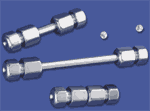|
Why Should I Use a Zirconia-Based HPLC
Column?
The primary advantage of zirconia over other
types of chromatographic materials used in HPLC today are summarized in the following
table that lists ideal chromatographic properties (1):
++ = Very good; + = good
performance; - = fair performance.
HPLC Property |
Zirconia |
Silica |
Polymers |
| Mechanical Stability |
++ |
++ |
+ |
| High Surface Area |
++ |
++ |
++ |
| Control of Average Pore Diameter |
++ |
++ |
+ |
| Control of Average Particle Diameter |
++ |
++ |
++ |
| Chemically Flexible |
+ |
++ |
+ |
| Energetically Homogeneous |
- |
- |
+ |
| Swelling |
++ |
++ |
- |
| Chemical Stability (to acid and base) |
++ |
- |
++ |
| Thermal Stability |
++ |
+ |
- |
As shown above, the primary advantage of zirconia
over either silica or polymeric stationary phases is its extreme chemical and thermal
stability. Unlike silica, zirconia is completely stable over the entire pH range and at
elevated column temperatures as high as 195 degrees celcius. Unlike polymeric phases,
zirconia does not shrink or swell as a function of mobile phase organic content or ionic
strength, and it has very high mechanical strength. This extreme stability results in a
column that may be cleaned under harsh conditions (acidic or basic), and also results in a
much longer column lifetime. Long column life and stability translates to a reduced cost
per analysis and a wider range of possible chromatographic conditions.
(1) J. Nawrocki, M.P. Rigney, A. McCormick, P.W.
Carr, J. of Chromatogr., 657 (1993) 229-282.
|










